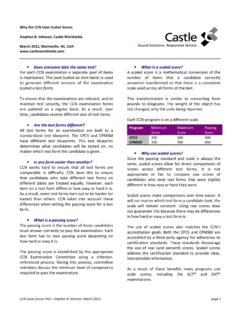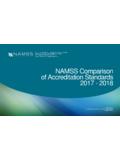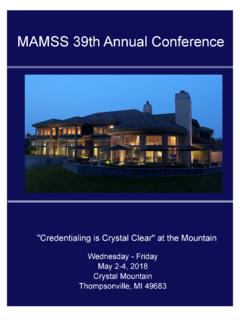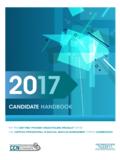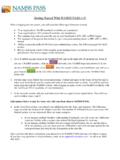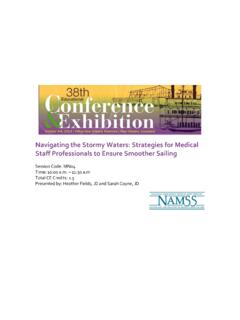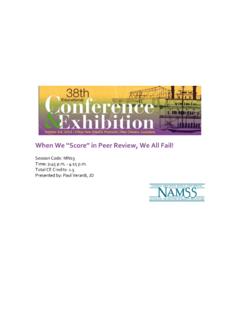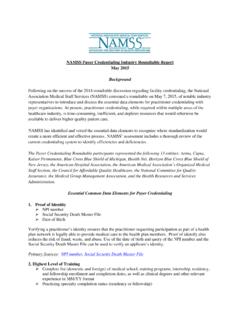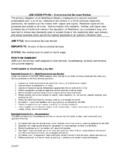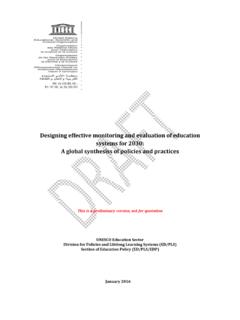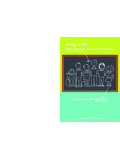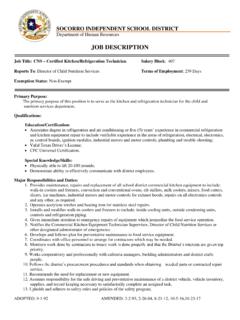Transcription of applicant’s career. applicant’s professional practice …
1 1 National Association Medical Staff Services | February 2014 The Ideal Credentialing Standards: Best practice Criteria and Protocol for Hospitals Credentialing best practices include an evidence-based evaluation that verifies 13 specific criteria from primary sources. Secondary sources such as a credential verification from another facility, copies of a credential verification, or confirmation from a source that verified the credential should only be used if primary source queries are unattainable. All information to support the following 13 criteria should be primary -source verified within 120 days at the time of credentialing review.
2 Each health facility and system should establish specific qualifications for medical staff membership and clinical privileges that reflect practitioner competency. They should incorporate the 13 criteria that NAMSS has identified as the Ideal Credentialing Standards into its medical staff bylaws, rules and regulations, and other governance documents to ensure that its credentialing process is objective, systematic, and without discrimination or bias. Just as credentialing assesses an applicant s professional abilities outlined in licensing scopes of practice , it also detects professional incompetence, malevolence, behavioral problems, or other red flags that would deter a health facility and system from employing and credentialing an applicant.
3 Although red flags do not automatically preclude a practitioner from the medical staff, Medical Services Professionals (MSPs) should perform a comprehensive review of a practitioner with any red flags, keeping in mind the relativity among different specialties, patient safety, and likelihood of lawsuits. Examples of red flags: Resignation from a medical staff at any time in an applicant s career . Reports of problems in an applicant s professional practice . All past or pending state licensing board, medical staff organization, or professional society investigative proceedings. Unexplained or unaccounted time gaps. No response to a reference inquiry from an applicant s past affiliation.
4 Disciplinary actions by medical staff organizations, hospitals, state medical boards, or professional societies. Any claims or investigations of fraud, abuse and/or misconduct from professional review organizations, third-party payers, or government entities. Little or no verified coverage from a professional liability insurance policy. Jury verdicts and settlements for professional liability claims (which should still be individually reviewed). Inability to maintain a medical practice within the facility s service jurisdiction for any amount of 2 National Association Medical Staff Services | February 2014 Verifying the following 13 criteria will generate the information necessary to assess an applicant s professional competence and personal decorum as well as help identify red flags or the need for further investigation.
5 1. Proof of Identity Government-issued photo identification NPI number I-9 documentation listed as List A or List B or C as defined on form VISA card or Employment Verification card A seemingly straightforward step, verifying a practitioner s identity with government-issued documentation and an identifiable photograph ensures that his/her identity is correct the critical first step to the credentialing process. Valid government-issued photo identification, in addition to any of the following three documents listed above, can be used to verify an applicant s identity. primary Sources: Government-issued identification. 2.
6 Education and Training Complete list (domestic and foreign) of medical school, internship, residency, and fellowship enrollment and completion dates, as well as clinical degrees and other relevant experience in MM/YY format Completion status Explanation of any time gaps Fifth Pathway certification, if applicable ECFMG validation All listed education and training entities that confirm training or education from medical school and beyond must include start and end dates. applicants are required to submit a written explanation of any time gap greater than 90 days. Time gaps shed light on details of an applicant s education and training experience that are not explicit in self-reported materials.
7 Explanations of these gaps, or lack thereof, may provide insight into an applicant s past that may be critical to the credentialing decision/recommendation. primary Sources: National Student Clearinghouse, AMA, AOA, ECFMG, and applicable professional schools or residency training programs. 3. Military Service DD214 if recently discharged; comprehensive list of military experience, including military branch and enlistment dates, if currently serving Similar to education and training history, verifying an applicant s military experience provides insight into an applicant s training and work history and overall professional competency.
8 The details derived from the above information provide a thorough overview of an applicant s training history and performance. Enlistment time gaps may not be as straightforward as education and training gaps, but should not be overlooked and may require further investigation, including a written explanation by the applicant. 3 National Association Medical Staff Services | February 2014 primary Sources: DD214, National Personnel Records Center (NPRC), verification from the applicable military branch, and current duty station. 4. professional Licensure Complete list and/or copies of all professional licensure including the issuing state, license type, license number, status, and issue and expiration dates The applicable state licensing agencies primary source verify the validity, dates, and status of licenses listed on an application.
9 Licenses obtained, held, and/or rescinded shed further light on an applicant s professional competency, performance, experience, and demeanor. Obtained licenses certify an applicant s ability to practice within the scope of each license held. Rescinded licenses provide insight into an applicant s history and may require further investigation such as a written explanation from the applicant. A practitioner must be licensed in the states in which he/she practices . MSPs should directly investigate surrendered licenses or license sanctions, restrictions, revocations, suspensions, reprimands, or probations that the licensing entity or the National Practitioner Data Bank (NPDB) verifies.
10 primary Sources: State licensing boards, FSMB. 5. DEA Registration and State DPS and CDS Certifications Complete list and/or copies of DEA, DPS, and/or CDS certificates including issuing state, status, registration number, and issue and expiration dates The Drug Enforcement Agency (DEA) confirms an applicant s DEA certification, as well as the states in which the applicant is certified to prescribe, dispense, or administer controlled substances at the time of the credentialing assessment. The listed DEA address must match the state in which the applicant practices . applicants in states that require a specific license or certificate to dispense, prescribe, or administer controlled substances must obtain Departments of Public Safety (DPS) and/or Controlled Dangerous Substance (CDS) certifications and abide by each state s rules, regulations, and renewal policies.

